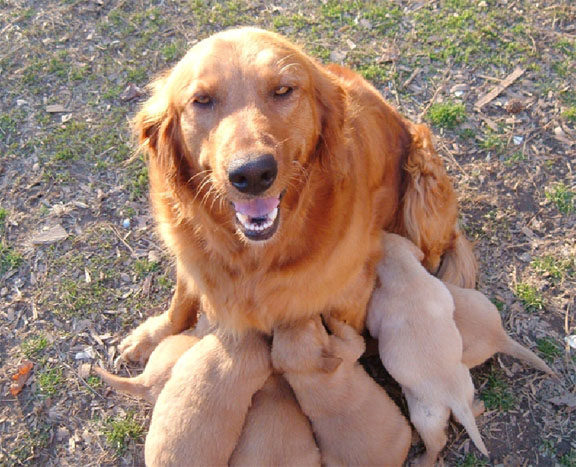(Continued)
So now the first puppy has arrived. Should you interfere or should you let nature take its course? Most bitches do not need help to give birth. I have always felt that the least amount of intrusion from us humans the better. You should only interfere in an emergency. Too much interference may cause the bitch to become nervous and prevent her from adequately caring for her newborn babies. However, many first-time mother dogs seem at a loss when their tiny, wriggling puppies emerge. Also, many dogs have become so attached to their owners, they look forward to some human assistance and support. If you are going to interfere then do so with the least amount of commotion; and your intervention should only be (i) remove the afterbirth from the puppy if its breathing is being compromised, and (ii) to place the mouth of the struggling, blind puppy on the nipple of the mother. Once the first pup begins suckling, the sucking action precipitates the milk flow. (That first milk is of great importance, since it has elements that support immunity and the young pup’s body defence; also it is very nutritious.)

Puppies can be born as close to each other as every 15 minutes or as far as every two hours. An average time for delivery of four to six puppies is six to eight hours, but a large litter may take considerably longer. Although puppies usually appear at regular intervals it is not a cause for concern if a puppy does not arrive for one or two hours. If the interval is longer than this, or if the bitch appears to be continuously straining and in distress, then something is wrong and your veterinarian must be contacted.
On occasion, the problem with delivery is minor and you can intervene. For example a large pup may get stuck at the vaginal opening. The head or presenting part appears during a forceful contraction, then slips back inside when the bitch relaxes. At this point it is wise to step in quickly and complete the delivery. Once a puppy moves out of the uterus down into the vaginal canal, oxygen from the bitch gets cut off. Delivery at this point must proceed rapidly. In the meantime, alert your vet that his/her services might be needed later on.

You may recall last week that I had mentioned that each pup is surrounded by its own afterbirth (placenta). If the mother dog does not remove each placenta membrane from around each pup’s nose and mouth within two minutes after birth, you will have to do so (see first paragraph above). Then, keeping the pup’s head down use a small bulb syringe (or anything that will function as a suction ‘pump’ to suck out any slime from the mouth or the nostrils of the pup. Rub the puppy vigorously but gently with a clean towel/cloth until it cries.
After the pup has been expelled, it is the mother’s job to sever the umbilical cord (see last week’s column). Again, if you have to intervene, clamp off the cord with your fingers, then cut it off with scissors. Now, tie the stump off with a piece of unwaxed dental floss or thread and dab the area with iodine.
If these measures are not immediately successful, you must contact your vet and solicit his/her advice.
After your bitch has delivered her last puppy (hours have elapsed and no other puppy has emerged), ask your veterinarian to examine her to be sure there are no retained puppies or placentas. He/she may administer an injection to clear the uterus. This injection also stimulates the letting down of milk.
Please implement disease preventative measures (vaccinations, routine dewormings, monthly anti-heartworm medication, etc) and adopt-a-pet from the GSPCA’s Animal Clinic and Shelter at Robb Street and Orange Walk, if you have the wherewithal to care well for the animals. Do not stray your unwanted pets, take them to the GSPCA’s Clinic and Shelter instead. If you do not wish your pet to have puppies or kittens, you may exploit the GSPCA’s free spay and neutering programme. If you see anyone being cruel to an animal, or if you need any technical information, please get in touch with the Clinic and Shelter by calling 226-4237.





